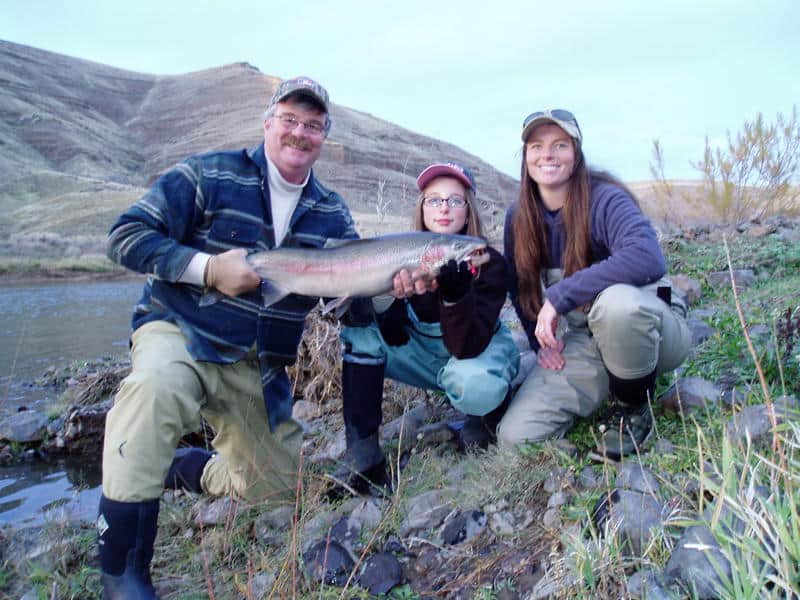Source: Fishing in Oregon: The Complete Oregon Fishing Guide (11th Edition) by Madelynne Diness Sheehan
Also see:
Best Fishing in Northeast Oregon (East, Snake River Drainage)
The Northeast Zone includes all waters draining into the Columbia River east of the Deschutes River and all waters draining into the Snake River system up to Hells Canyon Dam. This zone does not include any portion of the mainstem Columbia and Snake rivers.
The following are among the best fishing waters that drain into the Columbia River in the Northeast Zone:
John Day River (below Kimberly)
This stretch of mainstem is most noted for its world class smallmouth bass fishing and some great fall steelhead fishing. Smallmouth bass are most often fished from March through October.
The early season brings fewer catches but the best odds for catching very large fish, including bass well above 20 inches. Regulations limit harvest of larger bass to maintain the trophy fishery.
While there is no steelhead hatchery program on the John Day, fin-clipped fish from other river systems stray into this river regularly and may be kept. The more numerous wild steelhead must be released.
Although these are summer steelhead, fishing begins in the lower sections in September, with peak catches about November.
(NOTE: Recent seasons have brought seasonal protections for anadromous fish, so check before fishing.)
Due to the John Day Dam, the Columbia River backs into the John Day Arm section below Tumwater Falls. This water is good for smallmouth bass, channel catfish and other warmwater fish in spring and summer and for trolling for steelhead in the fall. It is reached from LePage Park at the John Day’s mouth.
More:
John Day River Smallmouth Bass Fishing (Spring Strategies)
John Day River Smallmouth Bass Fishing (Summer Tips)
John Day River, South Fork
This tributary of the upper John Day river offers good fishing for wild redband rainbow trout.
Other than about four miles upstream from where it enters the mainstem at Dayville, the stream mostly flows through public land and offers good access along South Fork Road.
Redbands are caught to 15 inches, and whitefish to about 13 inches also are present.
This stream, which has benefitted from restoration work, also provides spawning and rearing habitat for steelhead and salmon, but fishing for them is closed.
McKay Reservoir
This big reservoir near Pendleton offers good warmwater fishing, with abundant populations of crappie, yellow perch and brown bullheads. Largemouth bass can grow to good size, as attested by a past state record caught here, but overall fishing for them is fair.
Smallmouth bass also are now present. There are special regulations to protect larger bass, especially largemouths.
The reservoir also produced the current state record, but numbers of channel cats aren’t nearly as high here as they are on the Snake River system.
Because the reservoir is in the McKay Creek National Wildlife Refuge and is managed for waterfowl and irrigation, fishing is open from March 1 to Sept. 30. By the way, McKay is pronounced “McEye.”
Strawberry Lake
A drive south from Prairie City (east of John Day) and a pretty, one-mile hike leads to this scenic trout lake in the Strawberry Mountain Wilderness of the Malheur National Forest.
Access to this high-elevation lake can be tough early in the season. Fishing is best in spring and fall. There are both rainbow and brook trout. Fly fishing is good in the southern half of the lake.
There are several deep holes in the center and north end. Packing in a float tube is helpful.
Umatilla River
This river at times can have good fishing for summer steelhead, spring and fall chinook and fall coho salmon, plus trout in areas. It flows through Pendleton and Hermiston before joining the Columbia River at the town of Umatilla.
Salmon regulations can vary year to year, so check the latest rules before heading out.
Spring chinook enter the Umatilla from late March into April and are mostly caught in the lower three miles, but they also be landed farther upstream in downtown Pendleton.
Summer steelhead and fall chinook and coho fishing opens Sept. 1, when stronger runs allow all of these fisheries. Steelhead fishing extends to the following April 15, but salmon fishing ends after Nov. 30.
Upstream from the Umatilla Indian Reservation, particularly in the Bingham Springs area in the national forest, there is some good fishing for wild rainbow trout, which must be released in the upper river. Bull trout must also be released.
Walla Walla River
Once upon a time a fair steelhead stream near Milton-Freewater, which flows into Washington before joining the Columbia River. Steelhead fishing is likely closed as you read this, due to declining runs in recent years.
Ask for permission to fish from private property. There is some excellent rainbow trout fishing in the forks, especially in the South Fork.
Note: The lower South Fork Canyon is known for rattlesnakes, and the upper canyon is known for bears (especially when the berries are ripe).
Editor’s note:
Cold Springs Reservoir was previously listed among this area’s best fisheries, but this reservoir east of Hermiston suffers from from extreme water fluctuation and poor access, including a closed boat ramp.
A float tube or portable boat (only electric motors allowed) will improve your odds. During good water levels, the reservoir is capable of producing large and numerous black and white crappie.
The lake also has a variety of other warmwater fish. Note that the reservoir is in the Cold Springs Wildlife Refuge, portions of which are closed to fishing and motors.
Find places to fish in all 36 Oregon counties
Oregon Resources
ODFW Weekly Fishing Report
ODFW Trout Stocking Schedule
Oregon Fishing Regulations
National Weather Service

